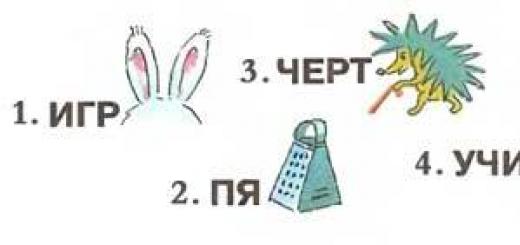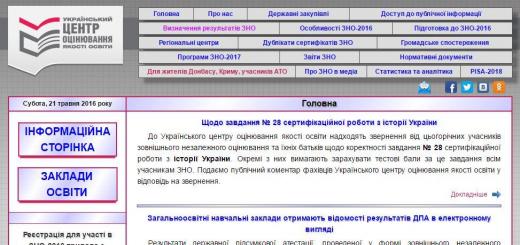In the last five years, the secondary education system in Ukraine has moved to another level and has undergone a number of fundamental changes. One of the main directions of its reform is the creation of a system of external unified testing, which should provide the possibility of objective comparison of the level of education in schools throughout the country.
External independent testing (Ukrainian “Zovnіshne nezalezhne testuvannya”, ZNO) is an examination for admission to higher educational institutions in Ukraine. Since 2008, a ZNO certificate is required for admission to a university. Initially, the ZNO took place during the school year, and the test results could be counted as final school exams. But since 2010, ZNO has been held after graduation, so students have to take both school exams and ZNO tests.
Throughout the country, ZNO takes place simultaneously, without interruption, in the form of a written test. The requirements and conditions for all its participants are the same. Any attempt by a student to violate testing regulations may result in the results being canceled. Therefore, passing the examination must be taken extremely seriously, because the future of the applicant will to some extent depend on its result.
In order to take part in testing, you must first register. Registration usually takes place in February. In order to register, it is necessary to prepare the required materials and documents (a full list of which is provided on the website of the Ukrainian Center for Assessment of the Quality of Education http://www.testportal.gov.ua/) and send them before the expiration of the registration period to the regional center. No later than three weeks later, the applicant will receive a response letter with either a certificate and registration card, or a refusal to register indicating the reasons. In the latter case, you need to eliminate them and send the documents for registration again.
The most difficult thing at the registration stage may be choosing the subjects that will have to be taken. It should be taken into account that the number of subjects that a graduate can take should not exceed four. In addition, you can only select one of the foreign languages.
The choice of subjects depends on the specialty for which you plan to enroll. There were cases when a graduate took the External Test in those subjects that he knew best, and then could not submit documents to the chosen university, because the wrong disciplines were indicated on the certificate. Therefore, in order to avoid such an unpleasant situation, you should check in advance on the websites of the relevant universities/institutes for the required disciplines.
In 2012, the list of disciplines available for passing contains:
- biology
- mathematics
- geography
- History of Ukraine
- Russian language
- The World History
- Ukrainian language and literature
- physics
- chemistry
- foreign languages (English, German, French, Spanish)
The schedule, as well as testing programs for all disciplines, are available on the UTSKO website http://www.testportal.gov.ua/. There you can also ask any questions you have regarding the organization and conduct of external assessment.
And finally, on the day of the test, you must arrive at the testing point at the appointed time, or better yet, a little early. After all, being late may cause you to be denied access to the test. You must have with you the document on the basis of which the registration was carried out (birth certificate or passport). Also, don’t forget a certificate, an invitation pass and two pens with black ink. Fulfilling these requirements will make it possible to be admitted to take the test.
An important issue is preparation for testing. As always, there are several options:
Economy option, it is independent; preparatory courses in universities; tutor help.
Those parents whose family budget is not ready for additional financial burden will have to make a choice in favor of independent preparation. There is nothing wrong with this, since future applicants are not required to do anything supernatural or beyond the scope of the school curriculum. Firstly, on the official website of UTSKO, as well as the Osvita portal (http://ru.osvita.ua/test/training/), you can find programs according to which test tasks are compiled, as well as a list of recommended textbooks and manuals. There you can also find examples of tests from previous years with answers. Secondly, you can purchase manuals for preparing for the external examination in bookstores. However, it should be taken into account that not all of the authors have an idea about the specifics of testing tasks, so you should focus on the list of recommended manuals. Thirdly, you can take online tests to test your knowledge and determine your level of preparation. Links to some of these services can be found on the Osvita portal (http://ru.osvita.ua/test/zno_online/). In addition, you can pay attention to the website “ZNO Tests Online” (http://zno.fizika.kiev.ua/)
True, most experts argue that in the case of self-preparation for the external examination, an applicant may lose sight of key points and miss some important details related to test tasks.
Preparatory courses at universities are expensive, but still have their advantages. As a rule, the website of each prestigious university has the necessary information about preparation courses for the External Test. Recruitment for courses usually takes place in September-October, and training starts in October-November. A good motivation for choosing this type of training in the past (2011) was the additional 20 rating points after completing the courses. Only those applicants who, upon completion of courses (at least 3 months of study) entered the same university for natural sciences, mathematics and engineering specialties, had the right to take advantage of this bonus. This year (2012) it is planned to maintain this bonus.
When choosing a tutor, you need to pay attention to his experience and level of training. On the Internet, many teachers, as well as students who want to earn extra money, offer their services, but it’s still worth listening to the advice of friends who have similar experience, or looking for a candidate with good reviews on your own.
Finally, if we summarize the cost of preparation for the external examination, we get the following financial picture:
Preparatory courses at higher educational institutions will cost 500-3000 UAH for the entire course, depending on the university and region. Private ZNO preparation courses will cost about 2000 - 3500 UAH. A tutor will charge on average from 50 to 150 per hour, depending on work experience and region. Self-study will require payment for the Internet, notebooks and pens.
ZNO is “Zovnіshne nezalezhne otsіnyuvannya”, or in Russian “External independent assessment”. Initially, it was tested on first-year university students, and since 2003 they began to gradually introduce it in schools.
What is ZNO at school?
External certification is called ZNO and includes a set of tests in several different subjects. ZNO is an analogue of the Russian Unified State Exam, consisting of several exams required for admission to the institute. In accordance with the order of the Ministry of Education, ZNO is carried out in the 11th grade. If a graduate fails to pass at least one subject, he will not be able to enroll in a higher education institution.
A trial is not for “copying” or “snooping”. The specific subject is essentially nothing. Is it approximately worse or better by comparing the transition tables.

The tests themselves It seems that those who graduated from school were mostly seated in separate rooms, and the turnout among them was significantly worse than average. Indeed, in a fair battle at the entrance exams (or, moreover, at the Olympiads), the author would have been accepted by any of these faculties. And if you took the regular exams, then you also had to take the Ukrainian one. And everything is written correctly about stereometry in mathematics. There is a small inaccuracy: 384 points were needed for the science department at KNU (I know exactly because a classmate had 384.5 and was afraid to fail.
Modern schoolchildren often cannot cope with the stress of a school-dependent test of knowledge, let alone an independent one... How can all this fit within the framework of every family? It is quite difficult, especially difficult for families where there is a low degree of trust between parents and children, and children towards parents. I can only reassure you a little by the fact that the EIT is written based on the average student; the tasks are not of astronomical complexity, but they require at least minimal experience in solving them and a level of knowledge in the subject.
Students should not hope for this because they went to school not for knowledge, but for entertainment. Anyone who wishes to enroll in a technical university takes an external examination in physics.
In 2016, the Ministry of Education decided to check whether it makes sense to take a foreign language test. Research began in the capital region and Lviv. Ukrainian literature and language cannot be replaced by anything. The third subject for ZNO is chosen based on the requirements of the university or institute where the graduate wants to become a student.
Students will not have to take the discipline twice – upon graduation and upon admission. The innovations of ZNO 2018 in Ukraine will affect children who are finishing fourth and ninth graders, who are going to study at a lyceum or college in their chosen profile. Students who do not have an international qualification will take a foreign language and a subject in their specialty.
But the trick is that the current scale was invented specifically to avoid absolute assessment of knowledge and move on to relative ones.
ZNO is a test that 11th grade students take.
External independent testing in chemistry, biology, and physics was carried out only for school graduates in the Kharkov region. Testing in the Ukrainian language took place on April 21, in chemistry, physics and biology - on April 26, in mathematics and history - on April 28. The main testing sessions will take place in June (from 2 to 23). Each school graduate must pass a test in Ukrainian language and literature and a choice of mathematics or history.
Cancer is a malignant neoplasm.
5. Cancer overdiagnosis index - the number of unconfirmed diagnoses per 100 cases of a cancer diagnosis established for the first time in life. Characterizes the quality of diagnosis.
Cancer is a malignant tumor that develops from epithelial cells, i.e. cells covering and lining almost all our organs and tissues. When cancer occurs, normal epithelial cells of the body are transformed into tumor cells, which begin to multiply uncontrollably, which leads to the occurrence of a malignant neoplasm.
What provokes this process? There are hundreds of known reasons that increase the risk of causing a malignant tumor. The share of diet in the development of cancer ranges from 30 to 35%, smoking - 30% (i.e. 2 out of 3 cases are caused by these factors), infectious (viral) agents - 17%, alcohol - 4%, environmental pollution - 2%, complicated heredity - 2%. The impact of these factors should be assessed together. About 80% of cases are associated with exposure to harmful environmental factors and lifestyle. Individual cancer prevention for each person consists of knowledge and compliance with practical recommendations in order to reduce cancer risk.
1. Don't smoke; if you smoke, stop. If you cannot quit smoking, then do not smoke in the presence of non-smokers.TO Urine determines at least 80% of lung cancer cases. Chemical and physical carcinogenic factors most intensely affect the lungs of a smoker, but can enter the gastrointestinal tract with sputum and saliva and affect the entire body. Each pack of cigarettes provides a dose of radiation exposure comparable to the dose of one image taken on a digital fluorograph. Tobacco smoke in the environment from smokers contributes to what is known as “passive smoking,” which has harmful effects on people who inhale it. Passive smoking increases the risk of lung cancer.
2. Try to avoid obesity. Fighting obesity and overweight, as well as maintaining physical activity, is best started at a young age. However, if you start following a healthy lifestyle at a later age, the positive effect will also be noticeable.
3. Be mobile and active, try to exercise every day. The protective effect of physical activity on cancer risk increases with increasing activity levels. Although such recommendations must be followed taking into account the general state of health.
4. Increase your daily intake and variety of vegetables and fruits. Limit your intake of foods containing animal fats. The low incidence of certain types of malignant tumors in the southern regions of Europe is associated with lower consumption of meat and fats of animal origin and higher consumption of fish, seafood, vegetables, fruits, and grains.
5. Limit the amount of alcohol you drink. Drinking alcoholic beverages increases the risk of cancer of the mouth, pharynx, larynx, and esophagus.
6. Try to avoid excess sun exposure. It is especially important to protect children and teenagers from the sun. People who are prone to sunburn should take protective measures throughout their lives. Skin cancer predominantly occurs among people with fair skin. The main external cause of skin cancer is exposure to the sun, namely the ultraviolet part of its spectrum. Skin melanoma is the most malignant and one of the most frequently metastasizing tumors, quickly leading to death. The risk of skin melanoma is associated with intermittent, intense sun exposure. An example of intense intermittent sun exposure is excessive sunbathing. The best protection from the sun is to stay out of its direct rays. Especially between 11 am and 3 pm, since the effect of ultraviolet rays is maximum at this time. This should be taken into account when planning outdoor activities, especially for children.
7. Strictly follow measures to prevent exposure to substances that are known to cause cancer. Follow all health and safety instructions when handling such substances. Science knows a large number of chemicals that can be carcinogenic (that is, capable of causing the development of malignant tumors). These include aromatic carbohydrates (benzopyrene, benzanthracene), aromatic amines (aniline dyes - naphthylamine), nitrogenous compounds, pesticides (herbicides, insecticides), mineral fertilizers, asbestos, etc. The source of most carcinogens in the environment is industrial emissions. Through contaminated soil, water, and air, carcinogens can enter the skin, lungs, and through food into the internal environment of the body and provoke the development of a tumor. Of the physical factors, various types of radiation deserve special attention.
The basis of cancer prevention is early detection and timely treatment of patients. The main task of preventing malignant tumors comes down to the active identification and treatment of patients with precancerous diseases and the identification of cancer patients at an early stage. One of the most active methods of early diagnosis and prevention of malignant tumors should include, first of all, preventive medical examinations of the population. A detailed history of the disease, attention to the patient’s complaints, completeness of the examination, literacy in assessing the results of the examination, medical examination of patients with precancerous diseases, constant oncological alertness, well-established health education - these are the main components of the early diagnosis of malignant tumors. Unfortunately, malignant tumors in the early stages do not have specific symptoms. It is important to be aware of some common signs and symptoms of cancer. It must be remembered that the presence of some of them does not necessarily mean the presence of a tumor.
You should definitely consult a doctor if you have:
-unexplained weight loss. Unmotivated weight loss of 4-5 kg may be the first sign of cancer, especially cancer of the pancreas, stomach, esophagus, and lung;
-prolonged increase in body temperature. Increased body temperature often occurs with cancer and most often with a common process. Less commonly, an increase in temperature can be an early sign of cancer, for example, with lymphogranulomatosis;
-increased fatigue. Fatigue can be an important symptom as the disease progresses. However, fatigue and weakness can occur at an early stage, especially if the cancer causes chronic blood loss, which occurs with colon or stomach cancer;
-pain. Pain can be an early sign of several tumors, such as those of the bones or testicle. But more often than not, pain is a symptom of a common process;
-skin changes. In addition to skin tumors, some internal cancers may cause visible skin signs such as darkening of the skin (hyperpigmentation), yellowing (jaundice), redness (erythema), itching, or excess hair growth;
-problems with bowel movements or bladder function: chronic constipation or diarrhea, which may be a manifestation of a colon tumor. Pain when urinating, blood in the urine, or urinating more frequently or less frequently may be signs of bladder or prostate cancer. These changes must be reported to your doctor immediately;
-non-healing wound or ulcer. Malignant skin tumors may bleed and resemble a wound or ulcer. A long-standing mouth ulcer may turn out to be oral cancer, especially in those who smoke, chew tobacco, or drink alcohol frequently. Sores on the penis or vagina can be both signs of infection and cancer and should be examined;
-unusual bleeding or discharge. Bleeding may occur against the background of early or advanced cancer. Blood in the sputum may be a sign of lung cancer. Blood in the stool is a sign of rectal or colon cancer. Cervical cancer and cancer of the uterus itself can lead to bleeding from the genital tract. Blood in the urine is a sign of possible bladder or kidney cancer. Drainage from the nipple may be a sign of breast cancer;
-lump or tumor in the breast or other parts of the body. Many tumors can be felt through the skin, especially in the breast, testicles, lymph nodes and soft tissues of the body.
-digestive and swallowing disorders. Although these symptoms can occur in various conditions, they at the same time may indicate the presence of cancer of the esophagus, stomach, or pharynx;
-change in wart or mole. You should be alerted to any change - change in color, size, shape, borders. The skin lesion may turn out to be melanoma, which, if diagnosed early, responds well to treatment;
Timely consultation with a doctor is the key to timely diagnosis and the key to successful treatment.
In general, to summarize what has been said, we can give the following tips for cancer prevention:
1.What to do? Undergo preventive examinations. Consult a doctor promptly regarding any diseases or health conditions. Strictly follow the recommendations of doctors for the examination and treatment of diseases, primarily those that may be precancerous. Currently available screening methods, which are widely used in mass preventive examinations of the population, include fluorography, mammography, cytological examination, and testing for occult blood in feces. According to existing regulations, all persons over 40 years of age must undergo a fluorographic examination of the chest organs annually. If pathological shadows or changes in the mediastinum are detected on fluorograms, a series of fluorograms should be carried out in different phases of breathing, as well as the use of special X-ray examination techniques.
2.What not to do? Everything else. First of all, get rid of bad habits, quit smoking and excess alcohol consumption.
Live a healthy and fulfilling life!
To improve the quality of oncological care in general and determine priority areas for service development, it is necessary to develop the most reliable and objective evaluation criteria. Based on the initiated “pilot” studies on the capabilities of cancer registries in monitoring the quality of oncology services, we analyzed the preventive, diagnostic and therapeutic measures of one of the oncology dispensaries in the Central Federal District of the Russian Federation. The analytical component of the cancer registry software package “Cancer-registry” was used, which allows you to obtain a wide range of data on the state of the oncological service both throughout the territory and in individual districts and settlements (a group of districts, settlements).To analyze the state of cancer care for the population, indices for a comprehensive assessment of the quality of activities aimed at early detection, diagnosis and treatment of malignant neoplasms have been developed.
The OOD Cancer Registry has been automated since 2000.
and contains data on more than 24,000 patients. For development, a database (DB) for 2004 was selected as the most complete and refined. The region includes 20 districts. In 2004, 4,627 cases of malignant neoplasm (MNT) were identified, among them 2,326 in men and 2,260 in women. Neoplasm topography codes C00-D09.
Indices for assessing the quality of preventive activities:
1. Index of active detection of cancer - the ratio of the number of cancers identified during preventive examinations to the total number of newly detected cancers (%).It is used to assess the effectiveness of preventive examinations of the population, characterizes the quality of medical examinations and screening programs. In total, the index for the region was 14.3%, among the male population - 12.8%, among the female population - 15.8%; the highest index was found in the region 18-28.2%, 24.6% and 32.1%, the lowest in region 10 - 6.7%, 8.3%, 4.8% and in region 9 - 5.8 %, 5.3%, 6.5% respectively.
The index was for the region as a whole for stomach cancer - 2.96%, rectal cancer - 8.89%, skin cancer (without melanoma) 27.63%, breast cancer - 30.14%, cervical cancer - 24.77 %, prostate gland - 7.77%.
2. Index of detection of pre-invasive forms of cancer - the ratio of the number of cases of pre-invasive cancer (cr in situ) per 100 cases of newly diagnosed cancer. The index characterizes the organization of early detection of cancer, the quality of work of examination rooms, preventive and screening programs, and cytological services.
A total of 42 cases of carcinoma in situ were identified in the region; more than a quarter (28.6%) of cases were detected in examination rooms and during preventive examinations. Almost half of the cases of carcinoma in situ were diagnosed in the regional center. One case of carcinoma in situ (D06.1) was detected in the patient as a second metachronous tumor (after 3 years).
In the region as a whole, this index was 0.97 for neoplasms of all locations, 0.23 for gastric cancer, 0.55 for rectal cancer, 0.70 for breast cancer, 0.59 for endometrial cancer, 0.71 for bladder cancer and 24 ,31 Cancer of the cervix.
3. The index of detection of patients with stages I and II of the disease at medical examinations - the ratio of the number of patients with stages I and II of the disease identified at medical examinations to the total number identified at medical examinations (in %) also characterizes the quality of the organization of early detection of cancer, preventive and screening programs.
The index was - for all neoplasms detected in stage I - 38.38%, stomach cancer - 7.69%, rectal cancer - 6.25%, skin cancer (without melanoma) - 88.59%, breast cancer - 15.50%, cervix - 66.67%, prostate gland - 6.25%; for all neoplasms detected in stage II - 28.75%, stomach cancer - 23.08%, rectal cancer - 56.25%, skin cancer (without melanoma) - 9.78%, breast cancer - 61, 24%, cervix - 22.22%, prostate - 25.00%.
Indices for assessing the quality of cancer diagnosis:
1. Timeliness of detection index - the ratio of the number of cancer cases detected in stages I and II of the disease to the total number of newly diagnosed cases (in %).The index was - for all neoplasms detected in stage I - 25.25%, stomach cancer - 7.52%, rectal cancer - 5.00%, skin cancer (without melanoma) - 90.09%, breast cancer - 12.38%, cervix - 37.61%, prostate gland - 11.17%; by region, the rate ranged from 10.7% in region 14 to 33.9% in region 17.
For all neoplasms detected in stage II - 21.19%, stomach cancer - 13.44%, rectal cancer - 43.89%, skin cancer (without melanoma) - 7.66%, breast cancer - 49, 07%, cervix - 32.11%, prostate gland - 21.36%.
2. Late diagnosis index - the ratio of the number of cases of cancer detected in stage IV of the disease to the total number of newly diagnosed cases. The index characterizes the level of late detection of cancer.
The index was - for all neoplasms detected in stage IV - 20.91%, stomach cancer - 36.67%, rectal cancer - 27.78%, skin cancer (without melanoma) - 0.30%, breast cancer - 10.28%, cervix - 14.68%, prostate gland - 11.17%.
3. Index of the use of modern diagnostic methods - the ratio of the number of cases of cancer with an unknown stage of the disease to the total number of newly diagnosed cases. Characterizes the completeness and quality of the use of modern diagnostic methods. This index is the most informative for visual localization malignancies.
The index was for gastric cancer - 1.37%, rectal cancer - 1.11%, skin cancer (without melanoma) - 0.45%, breast cancer - 0.93%, cervical cancer - 1.83%, prostate gland - 0%.
4. Index of morphological verification of diagnosis - the proportion of morphologically (including cytological methods) confirmed diagnoses of cancer to the total number of newly diagnosed cases of cancer. Characterizes the quality of diagnosis and the level of qualifications of doctors in identifying patients with cancer.
The index was - for all neoplasms - 79.26%, stomach cancer - 81.78%, rectal cancer - 92.22%, skin cancer (without melanoma) - 99.40%, breast cancer - 96.03%, cervix - 97.25%, prostate gland - 94.17%.
5. Cancer overdiagnosis index - the number of unconfirmed diagnoses per 100 cases of a cancer diagnosis established for the first time in life. Characterizes the quality of diagnosis. In the region, this index was 0.55% for cancerous tumors of all locations.
Indices for assessing the quality of cancer treatment:
1. Radical treatment coverage index - the ratio of the number of radically treated newly diagnosed cancers to the total number of newly diagnosed cancers (%).The index was - for all neoplasms - 48.90%, stomach cancer - 30.98%, rectal cancer - 54.44%, skin cancer (without melanoma) - 83.03%, breast cancer - 61.92%, cervix - 58.725%, prostate gland - 26.21%.
2. Index of the use of various methods of special treatment - the ratio of the number of cases of cancer radically treated with a certain method of treatment (surgical, radiation, combined/complex) to the total number of cases of cancer treated radically (%). The most informative analysis of this index for individual localizations, taking into account the stages of the malignant process.
3. An index characterizing the level of medical care, resuscitation and anesthesiological capabilities - the ratio of the number of cases of cancer in patients with contraindications to treatment to the total number of first detected cancers (%).
The index was - for all neoplasms - 9.27%, stomach cancer - 12.30%, rectal cancer - 5.00%, skin cancer (without melanoma) - 0.45%, breast cancer - 4.21%, cervix - 5.50%, prostate gland - 7.77%.
4. The treatment refusal index characterizes the level of organization of medical care and reserve opportunities for increasing the survival of patients - the ratio of the number of cases of cancer detected in the early stages in patients who refused treatment to the total number of cases of cancer in patients who refused treatment (%). It is advisable to analyze the indices separately for stages I and II of the disease. The index for all neoplasms detected in stage I was 23.33%. for those identified in stage II - 24.43%.
In a comprehensive analysis of indices characterizing preventive activities in the region, it can be noted that preventive programs for identifying cervical cancer in women are organized with the highest quality, with insufficient attention to the pathology of the mammary glands and skin; the organization of preventive examinations among men is at a low level.
Analysis of the values of indices characterizing the diagnostic capabilities of oncological services in the region under study allows us to conclude that there is a fairly high level of development of diagnostic services with insufficient organization of active detection of cancer.
Indices for assessing the quality of cancer treatment show that the most high-tech (combined/complex) method covered less than a quarter of cancer cases subject to treatment. The level of treatment refusal index for patients with early stages of cancer is quite high. For dynamic monitoring of the oncological situation in the region, the indices obtained as a result of the study should be considered as basic.
In future work, it is planned to study the above indices over time, and, if necessary, develop and analyze additional, more detailed indicators in conjunction with the activities carried out in the region for the early detection, diagnosis and treatment of cancer.










